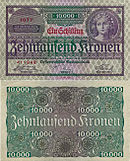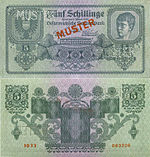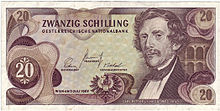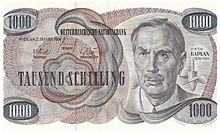- Austrian schilling
-
"Schilling" redirects here. For other uses, see Schilling (disambiguation).
Österreichischer Schilling
(German)
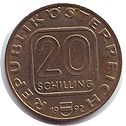
20 schilling 20 schilling ISO 4217 code ATS User(s)  Austria
AustriaInflation 2% Source CIA World Factbook 2001 ERM Since 19 June 1989 Fixed rate since 31 December 1998 Replaced by €, non cash 1 January 1999 Replaced by €, cash 1 January 2002 € = S 13.7603 Subunit 1/100 groschen Symbol S or öS Plural schilling groschen groschen Coins Freq. used 10 & 50 groschen, 1, 5 & 10 schilling Rarely used 1, 2 & 5 groschen, 20 & 50 schilling Banknotes 20, 50, 100, 500, 1000 & 5000 schilling Central bank Oesterreichische Nationalbank Website www.oenb.at Mint Münze Österreich Website austrian-mint.com This infobox shows the latest status before this currency was rendered obsolete. The schilling was the currency of Austria from 1924 to 1938 and from 1945 to 1999, and the circulating currency until 2002. The euro was introduced at a fixed parity of €1 = 13.7603 schilling to replace it. The schilling was divided into 100 groschen.
Contents
History
First schilling
The schilling was established by the Schilling Act (Schillingrechnungsgesetz) of December 20, 1924 at a rate of 1 schilling to 10,000 Austro-Hungarian Kronen and issued on March 1, 1925. The schilling was abolished in the wake of the Anschluss (1938), when it was exchanged at a rate of 2 German Reichsmark to 3 schilling.
Second schilling
The schilling was reintroduced after World War II on November 30, 1945 by the Allied Military, who issued paper money (dated 1944) in denominations of 50 groschen up to 100 schilling. The exchange rate to the Reichsmark was 1:1, limited to 150 schilling per person. The Nationalbank also began issuing schilling notes in 1945 and the first coins were issued in 1946.
With a second "schilling" law on November 21, 1947, new banknotes were introduced. The earlier notes could be exchanged for new notes at par for the first 150 schilling and at a rate of 1 new schilling for 3 old schilling thereafter. Coins were not affected by this reform. The currency stabilised in the 1950s, with the schilling being tied to the U.S. dollar at a rate of $1 = 26 schilling. Following the breakdown of the Bretton Woods system in 1971, the schilling was initially tied to a basket of currencies and then, in July 1976, the schilling was coupled to the German mark.
Although the euro became the official currency of Austria in 1999, euro coins & notes were not introduced until 2002. Old schilling denominated coins & notes were phased out from circulation because of the introduction of the euro by 28 February of that year. Schilling banknotes & coins which were valid at the time of the introduction of the euro will remain exchangeable for euros at any branch of the Austrian National Bank (Oesterreichische Nationalbank) indefinitely.
Coins
First schilling
In 1925, bronze 1 and 2 groschen, cupro-nickel 10 groschen, and silver ½ and 1 schilling coins were introduced, followed by cupro-nickel 5 groschen issues in 1931. In 1934, cupro-nickel 50 groschen and 1 schilling were introduced, together with silver 5 schilling. Coins were issued until 1938.
Second schilling
50 schilling 1974 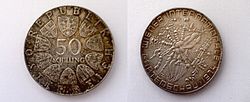
Value encircled by the Austrian coat-of-arms (at top) and coats of arms of the nine states of Austria International Garden Exhibition 640‰ silver, 20 g. The first year of reduced silver content in 50 schilling coin. Between 1947 and 1952, coins in denominations of 1, 2, 5, 10, 20, and 50 groschen; and 1, 2, and 5 schilling were introduced. The 2 and 50 groschen; 1, 2, and 5 schilling were struck in aluminium, as was the second type of 10 groschen coin. The 1 and 5 groschen and the first type of 10 groschen were in zinc, with the 20 groschen struck in aluminium-bronze. The 1 groschen was only struck in 1947, while the 20 groschen and 2 schilling coins were suspended from production in 1954 and 1952, respectively. In 1957, silver 10 schilling coins were introduced, followed in 1959 by aluminium-bronze 50 groschen and 1 schilling, and in 1960 by silver 5 schilling coins. Thus, the 5 schilling coins went from an aluminium composition to a silver one, a highly unusual event made possible by the substantial improvement of the Austrian economy in the 1950s. Cupro-nickel replaced silver in the 5 and 10 schilling coins in 1969 and 1974, respectively. An aluminium-bronze 20 schilling coin was introduced in 1980.
At the time of the changeover to the euro, coins in circulation were the following. Coins under 10 groschen were rarely seen in circulation during the final years of validity.
Last Circulating Coins[1][2][3] Image Value € equiv. Technical parameters Description Date of Diameter Mass Composition Edge Obverse Reverse first minting first issue last minting end of legal tender status 

1 groschen 0.07 cent 17 mm 1.8 g 100% zinc Smooth State title, coat of arms Value, year of minting 1947 5 April 1948 1950 31 December 2001 

2 groschen 0.15 cent 18 mm 0.9 g 98.5% aluminium
1.5% magnesiumCoat of arms State title, value, year of minting 1950 15 July 1950 1991 31 December 2001 

5 groschen 0.36 cent 19 mm 2.5 g 100% zinc Notched State title, coat of arms Value, year of minting 1948 17 June 1948 1992 31 December 2001 
10 groschen 0.73 cent 20 mm 1.1 g 98.5% aluminium
1.5% magnesiumSmooth Coat of arms Value, year of minting 1951 27 November 1951 1998 31 December 2001 
50 groschen 3.63 cent 19.5 mm 3 g 91.5% copper
8.5% aluminiumSerrated Shield, state title Value, gentian flower, year of minting 1959 1 October 1959 1997 31 December 2001 
S 1 7.27 cent 22.5 mm 4.2 g Smooth State title, value, year of minting Edelweiss flowers, value 1959 1 September 1959 1998 31 December 2001 
S 5 36.34 cent 23.5 mm 4.8 g Cupronickel1
75% copper
25% nickelSmooth State title, horse rider Shield, value, year of minting 1968 15 January 1969 1998 31 December 2001 
S 10 72.67 cent 26 mm 6.2 g Serrated State title, coat of arms Woman, value, year of minting 1974 17 April 1974 1998 31 December 2001 
S 20 1.45 27.7 mm 8 g Aluminium bronze
92% copper
6% aluminium
2% nickelSmoothly with 19 points/Smooth 2 State title, the nine Austrian provinces Value, year of minting 1980 10 December 1980 1993 31 December 2001 
S 20 State title, value, shield, year of minting Various commemorative subjects 1982 27 March 1982 2001 31 December 2001 

S 50 3.63 26.5 mm
Core: 18.5 mm8.15 g Ring: Aluminium bronze (as S 20)
Center: Magnimat 7Smooth State title, value encircled by the coats-of-arms of the states of Austria Various commemorative subjects 1996 23 October 1996 2001 31 December 2001 These images are to scale at 2.5 pixels per millimetre. For table standards, see the coin specification table. - 10 schilling has pure nickel core
- Smoothly with 19 points until 1992. In 1993, all previous 20 schilling coins were reissued with smooth edges.
Banknotes
First schilling
In 1925, notes were introduced by the Austrian National Bank in denominations of 1, 5, 10, 20, 100 and 1,000 Schillinge (note the different spelling of the plural on this first 1925-series of notes).
In 1927-1929 a second series was added with 5, 10, 20, 50 and 100 schilling notes. The one Schilling was substituted by a coin.
Second schilling
In 1945, the Allies introduced notes (dated 1944) in denominations of 50 groschen, 1, 2, 5, 10, 20, 25, 50, 100 and 1,000 schilling[4]. The National Bank also introduced notes in 1945, in denominations of 10, 20, 100 and 1,000 schilling and the allied currency with smale values up to 5 schilling remained valid until 1947. With the banknote reform of 1947, new notes were issued in denominations of 5, 10, 20, 50, 100 and 1,000 schilling. Until 1957, the first 500 schilling banknote was issued and the 5 and 10 schilling notes were replaced by coins. However, although 20 schilling coins were issued from 1980, the 20 schilling note continued to be produced, with 5,000 schilling notes added in 1988.
1983 Series[5] Image Front Image Back Value € equiv. Dimensions Description Date of Obverse Reverse printing issue 

S 20 1.45 123 × 61.5 mm Moritz Daffinger Albertina (Vienna) 1 October 1986 19 October 1988 

S 50 3.63 130 × 65 mm Sigmund Freud Josephinum (Alsergrund, Vienna) 2 January 1986 19 October 1987 

S 100 7.27 137 × 68.5 mm Eugen von Böhm-Bawerk Akademie der Wissenschaften 2 January 1984 14 October 1985 S 500 36.34 144 × 72 mm Otto Wagner Post Office Savings Bank, Vienna 1 July 1985 1986 

S 1000 72.67 152 × 76 mm Erwin Schrödinger University of Vienna 3 January 1983 1983 

S 5000 363.36 160 × 78 mm Wolfgang Amadeus Mozart Wiener Staatsoper 4 January 1988 17 October 1989 1997 Series Image Front Image Back Value € equiv. Dimensions Description Date of Obverse Reverse printing issue S 500 36.34 147 × 72 mm Rosa Mayreder Rosa Mayreder 1 January 1997 20 October 1997 

S 1000 72.67 154 × 72 mm Karl Landsteiner Karl Landsteiner 1 January 1997 20 October 1997 These images are to scale at 0.7 pixels per millimetre. For table standards, see the banknote specification table. See also
References
- ^ Oesterreichische Nationalbank. "Gesamtverzeichnis der Schillingmünzen von 1947 bis 2001" (in German) (PDF). http://www.oenb.at/en/img/schillingmuenzen_tcm16-774.pdf. Retrieved 2006-10-23.
- ^ Münze Österreich. "Coin Catalogue". http://austrian-mint.at/cms/cms.php?pageName=155. Retrieved 2006-10-23.
- ^ Oesterreichische Nationalbank. "Circulation Coinage". Archived from the original on 2005-03-17. http://web.archive.org/web/20050317113502/http://www.austrian-mint.com/e/hartgdmen.html. Retrieved 2006-10-23.
- ^ Allied Military Currency
- ^ Oesterreichische Nationalbank. "From the Schilling to the Euro". Archived from the original on 2006-09-24. http://web.archive.org/web/20060924043631/http://www.oenb.at/en/ueber_die_oenb/geldmuseum/oesterr_geldgeschich/schilling/from_the_schilling_to_the_euro.jsp. Retrieved 2006-10-23.
- Krause, Chester L. and Clifford Mishler (2003). 2004 Standard Catalog of World Coins: 1901–Present. Colin R. Bruce II (senior editor) (31st ed. ed.). Krause Publications. ISBN 0873495934.
- Cuhaj, George S. (editor) (2006). Standard Catalog of World Paper Money: Modern Issues 1961-Present (12th ed.). Krause Publications. ISBN 0-89689-356-1.
External links
- Overview of the Austrian schilling from the BBC
- Library of Congress Country Studies Reports
- Banknotes Austria - Pictures of nearly all Austrian shilling banknotes
- Austrian banknotes explained and historical background information
Old Schilling Preceded by:
Austrian krone
Reason: inflation
Ratio: 1 Schilling = 10,000 KronenCurrency of Austria
1925 – 1938Succeeded by:
German Reichsmark
Reason: German annexation (anschluss)
Ratio: 1 Reichsmark = 1.5 SchillingAllied Military Schilling Preceded by:
German Reichsmark
Reason: restoration of sovereignty, under allied occupation
Ratio: at par, limited to 150 schilling per personCurrency of Austria
November 30, 1945 – November, 1947Succeeded by:
New Schilling
Reason: inflation
Ratio: at par for the first 150 schilling per person, then 1 new schilling = 3 Allied Military SchillingNew Schilling Preceded by:
Allied Military Schilling
Reason: inflation
Ratio: at par for the first 150 schilling per person, then 1 Schilling = 3 allied military schillingCurrency of Austria
1947 – December 31, 2001
Note: euro existed as an accounting currency since 1 January 1999Succeeded by:
Euro
Reason: deployment of euro cash
Ratio: 1 euro = 13.7603 schillingCategories:- History of Austria
- Currencies replaced by the euro
- Modern obsolete currencies
- Currencies of Austria
- 1924 establishments in Austria
Wikimedia Foundation. 2010.


